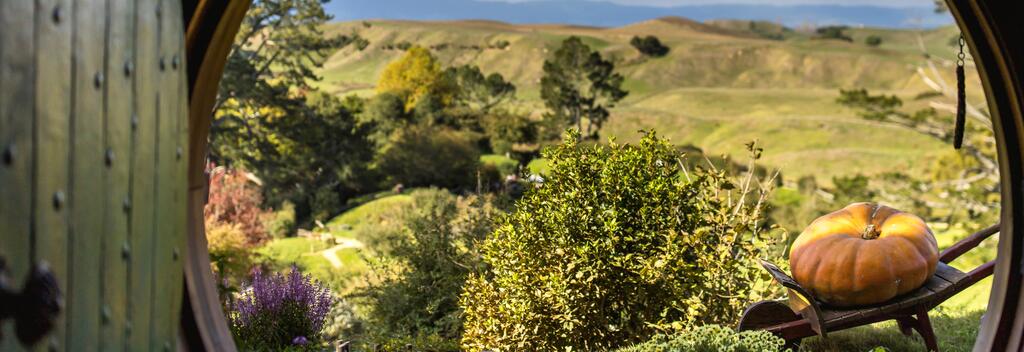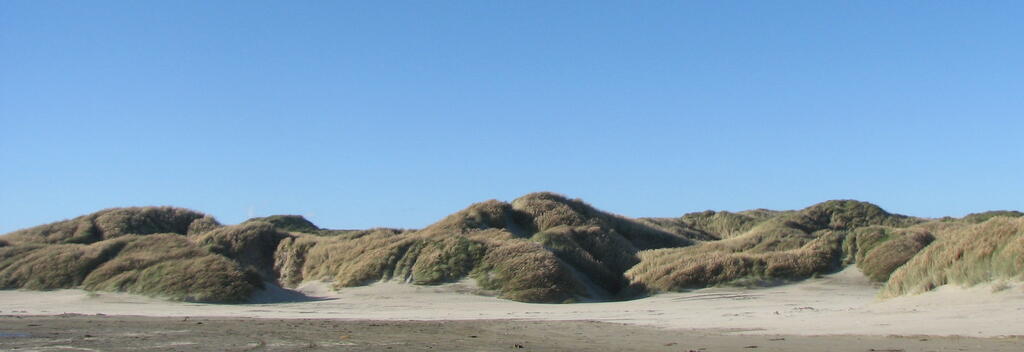-
Popular places to visit
Popular things to do
Helpful tips
Here's a few useful links to help with planning your trip to Aotearoa New Zealand.
-


New Zealand film directors love shooting in their home country. Here are ten film locations that demonstrate why.
When farmer Russell Alexander looked at his Waikato farm he saw 500 hectares of prime farmland and the result of decades of hard work. When director Sir Peter Jackson peered over the fence with his binoculars, he saw the bucolic English countryside and the perfect setting for a Hobbit village. These days, Alexander Farm is happily both farm and filmset. Surrounded by paddocks of Alexander’s sheep, Hobbiton™ Movie Set Tours comprises 44 hobbit-sized houses, a fully-fledged Green Dragon Inn, and a lake with a picturesque mill. You must imagine the rest: there are no people dressed as Hobbits, waving and smiling Disney-style, here (unless you count the occasional visitor).
The tiny Central Otago town of Roxburgh stands in for the fictional Rapata Junction in ‘In My Father's Den’. The town, along with Otago’s imposing mountain ranges, is a striking backdrop for this turn-of-the-century murder mystery. Not enough people saw this film about a troubled war photographer to appreciate either the backdrop or Matthew Macfadyen’s thoughtful performance (yes, he was discovered here first). But even if you haven’t seen the film, you can still appreciate the small-town joys of Roxburgh – thankfully not made famous and touristy by box office success.
Before moving to Hollywood Takia Waititi(opens in new window) wrote, directed, and occasionally starred in his own films. If he had a signature style it could be described as mildly tragicomic, with the emphasis being on comic. His films had strongly defined characters, a deadpan take on life’s absurdities, and a deep sense of place. The latter is, perhaps, most strongly expressed in ‘Boy’, a film about growing up in a rural community that was shot in Takia’s hometown of Waihau Bay in the Bay of Plenty. If Takia's films are, like the man himself, downbeat and good natured, it is not hard to see why growing up in a small town might have been an influence.
Thirty years on, ‘The Piano’s’ cinematography is just as arresting. With lead characters comprising a mute heroine and male leads whose inarticulacy is a plot point, director Jane Campion was not entirely joking when she described 'The Piano' as a silent movie. For this reason much of the story is told visually, often through New Zealand’s dramatic landscapes. New Zealand filmmaking practically came of age with Ada (mute heroine) collapsing into the forest mud and one of the most memorable tableaus in New Zealand cinema history: the abandoned piano on weather-worn Karekare Beach.
It is difficult to think of a more appropriate setting for the elven kingdom of Lothlórien than Milford Sound. Located in a remote corner of the South Island, its imposing fjords and dark waters seem untouched by people or time. Director Sir Peter Jackson chose to film the ‘Lord of the Rings’ trilogy in New Zealand because of the country’s ‘raw beauty’ – and Milford Sound certainly is New Zealand at its rawest and most beautiful.
Had Jane Campion not been a film director, cinematography might have been her calling. In 'The Power of the Dog’ her painterly impulses are particularly vivid. Here, the Hawkdun Ranges(opens in new window) stand in for muse. They are a spectacular visual feature, often looming in the background, oddly shaped and caramel coloured. Before filming began, Jane returned again and again to the mountain range to check the light during different seasons and at different times of day. In the film, she uses light to create drama – most strikingly through the chiaroscuro effect of light and shadow over the mountain ranges, which is symbolic, you might say, of the film’s subject matter.


When New Zealand’s landscapes feature in Hollywood films they are usually in the role of mythical universe. And Flock Hill in Canterbury, with its surreal limestone boulders and imposing mountain ranges, is one of the most obvious places for good and evil to battle it out. The area is photogenic but has enough drama to support a bit of blood and gore. In ‘The Chronicles of Narnia: The Lion, the Witch and the Wardrobe’, Director Andrew Adamson uses almost every feature of the landscape for his battle scene – from long shots of charging armies crossing rolling hills to close-up shots of face-offs between hero and witch over carbonate sedimentary rock.
Director Jane Campion is known for choosing eye-catching settings for her films and 'Top of the Lake' is no exception. Here, the idyllic rural settings of Lake Moke, Glenorchy, and Queenstown contrast sharply with the detective drama’s gritty subject matter.


When an ancient Chinese folk hero takes on Rouran warriors, she needs an epic location for her battle scene. Naturally, Director Niki Caro turned to her own backyard to find the perfect filming location for the Disney's remake of ‘Mulan’. Caro says the Ahuriri Valley(opens in new window) ticked all the boxes for a battle scene. It has the stunning Southern Alps in the background, an expansive valley floor (ideal for long shots), and a defined terraced riverbed (useful vantage points for actors in midrange shots).


The cinematography of 'The World’s Fastest Indian' is exquisite but even cinematography can’t capture the rugged beauty of windswept Ōreti Beach, at the very bottom of the South Island. Between here and Antarctica there’s not much besides the Southern Ocean, but the water is not as cold as you might imagine.